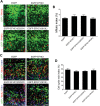Mutations of EFHC1, linked to juvenile myoclonic epilepsy, disrupt radial and tangential migrations during brain development
- PMID: 22926142
- PMCID: PMC3490517
- DOI: 10.1093/hmg/dds356
Mutations of EFHC1, linked to juvenile myoclonic epilepsy, disrupt radial and tangential migrations during brain development
Abstract
Heterozygous mutations in Myoclonin1/EFHC1 cause juvenile myoclonic epilepsy (JME), the most common form of genetic generalized epilepsies, while homozygous F229L mutation is associated with primary intractable epilepsy in infancy. Heterozygous mutations in adolescent JME patients produce subtle malformations of cortical and subcortical architecture, whereas homozygous F229L mutation in infancy induces severe brain pathology and death. However, the underlying pathological mechanisms for these observations remain unknown. We had previously demonstrated that EFHC1 is a microtubule-associated protein (MAP) involved in cell division and radial migration during cerebral corticogenesis. Here, we show that JME mutations, including F229L, do not alter the ability of EFHC1 to colocalize with the centrosome and the mitotic spindle, but act in a dominant-negative manner to impair mitotic spindle organization. We also found that mutants EFHC1 expression disrupted radial and tangential migration by affecting the morphology of radial glia and migrating neurons. These results show how Myoclonin1/EFHC1 mutations disrupt brain development and potentially produce structural brain abnormalities on which epileptogenesis is established.
Figures






References
-
- Delgado-Escueta A.V., Enrile-Bacsal F. Juvenile myoclonic epilepsy of Janz. Neurology. 1984;34:285–294. - PubMed
-
- Noebels J.L., Avoli M., Rogawski M.A., Olsen R.W., Delgado-Escueta A.V. The next decade of research in the basic mechanisms of the epilepsies. In: Noebels J.L., Avoli M., Rogawski M.A., Olsen R.W., Delgado-Escueta A.V., editors. Jasper's Basic Mechanisms of the Epilepsies. Oxford University Press; 2012. pp. 3–11.
-
- Suzuki T., Delgado-Escueta A.V., Aguan K., Alonso M.E., Shi J., Hara Y., Nishida M., Numata T., Medina M.T., Takeuchi T., et al. Mutations in EFHC1 cause juvenile myoclonic epilepsy. Nat. Genet. 2004;36:842–849. - PubMed
-
- Ma S., Blair M.A., Abou-Khalil B., Lagrange A.H., Gurnett C.A., Hedera P. Mutations in the GABRA1 and EFHC1 genes are rare in familial juvenile myoclonic epilepsy. Epilepsy Res. 2006;71:129–134. - PubMed
Publication types
MeSH terms
Substances
Grants and funding
LinkOut - more resources
Full Text Sources
Molecular Biology Databases

